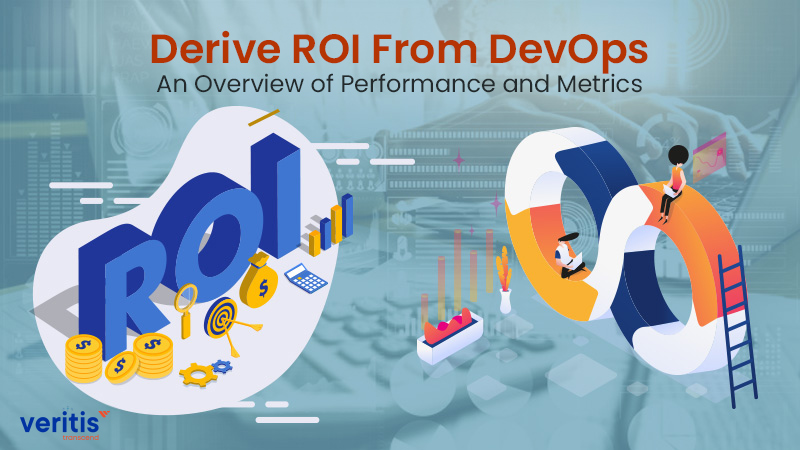
Table of contents
- What is ROI From DevOps and How to Measure it
- Significance of Evaluating DevOps Return on Investment (ROI)
- How to Calculate DevOps ROI
- Determine Advantages
- Deriving ROI from DevOps
- Current Statistics for DevOps
- What to Measure for DevOps ROI?
- Key DevOps Metrics to Measure ROI
- Calculating ROI from DevOps
- DevOps Implementation Roadmap
- Conclusion
DevOps brought about a significant change in the software delivery process. It has increased the pace of software delivery and facilitated a new form of collaboration among the teams involved. This, in turn, resulted in a flexible environment, causing an overall cultural transformation within the organizational functioning. All these are directly reflected in enhanced performance, improved productivity, reduced time-to-market, DevOps cost savings, lower failure rates, and faster recovery.
Because of these benefits, DevOps’ popularity has been growing by leaps and bounds and continues to skyrocket. What drove this DevOps demand? Organizations say it’s the Return on Investment (ROI) on DevOps investment—commonly referred to as DevOps ROI.
What is ROI From DevOps and How to Measure it
A company’s success hinges on the velocity of its software development efforts. Many IT companies have adapted and evolved in response to technological trends, embracing advanced software delivery practices.
DevOps has exceeded expectations and brought significant advantages to organizational business functions. Organizations increasingly favor DevOps ROI metrics for business due to its holistic and intuitive work culture. When considering the adoption of DevOps for your company, it’s crucial to understand that it encompasses a series of interconnected processes—including software development, testing, deployment, and automation—executed promptly, reliably, and consistently.
DevOps has expedited the software delivery pipeline and contributed to an improved customer experience, timely failure detection, DevOps cost savings, swift recovery, and more.
Beyond the benefits, organizations must address a notable concern as they embark on their DevOps transformation journey: how to quantify the Return on Investment (ROI) of DevOps? Let’s delve into the following sections for an in-depth exploration of this question.
Exploring the Significance of Evaluating DevOps Return on Investment (ROI)
The DevOps Return on Investment (ROI) assessment is pivotal for organizations aiming to gauge the financial repercussions of their investments in integrating a DevOps culture. Through quantitative ROI analysis, enterprises can glean invaluable data regarding the efficiency of their DevOps methodologies and pinpoint areas for enhancing productivity, DevOps cost savings, and revenue augmentation.
A primary advantage of assessing DevOps ROI lies in giving organizations a lucid comprehension of the efficiency with which teams collaborate and deliver value to their customer base. This methodology facilitates the evaluation of the genuine returns stemming from investments in DevOps benefits for business, achieved by scrutinizing key DevOps metrics, including cycle time, deployment frequency, and customer satisfaction. This data-driven approach empowers companies to make well-informed decisions regarding resource allocation and process enhancements.
Without a quantitative evaluation of DevOps ROI, organizations may encounter difficulties rationalizing additional investments in their transformation endeavors. By quantifying the fiscal consequences of adopting a DevOps culture, enterprises can furnish stakeholders with concrete outcomes, garnering support for forthcoming initiatives. This assessment also aids in prioritizing efforts by identifying areas necessitating further focus or financial allocation.
Useful link: Building a High-Performing DevOps Culture: Strategies and Best Practices for CEOs and CTOs
How to Calculate DevOps ROI
The precise computation of your DevOps undertakings’ Return on Investment (ROI) is paramount for grasping the organizational worth they deliver. Adhering to a systematic, sequential approach, you can reliably ascertain the influence of DevOps implementation on your financial outcomes and make judicious choices concerning forthcoming investments.
Calculate Total Costs
Commencing the computation of your DevOps ROI necessitates a comprehensive evaluation of all pertinent expenses linked to your development procedures. These encompass costs attributed to tooling, training, infrastructure, and personnel, each vital in establishing and sustaining an effective DevOps implementation strategy.
1) Tooling Costs
Account for the expenses of procuring and licensing the requisite DevOps tools for streamlined collaboration, monitoring, deployment, and DevOps automation ROI.
2) Training Expenditures
Include any costs incurred for training your workforce using new DevOps tools or adopting processes aligned with the DevOps strategy.
3) Infrastructure Investments
Evaluate the financial outlays tied to infrastructure enhancements or expansions that support continuous integration/continuous delivery (CI/CD) pipelines and other fundamental elements of a resilient DevOps ecosystem.
4) Personnel Outlay
Consider salaries, benefits, and other personnel-related costs directly linked to establishing and maintaining a thriving DevOps culture within your organization.
Useful link: DevOps outsourcing: Things to Know About Before Getting Started
Determine Advantages
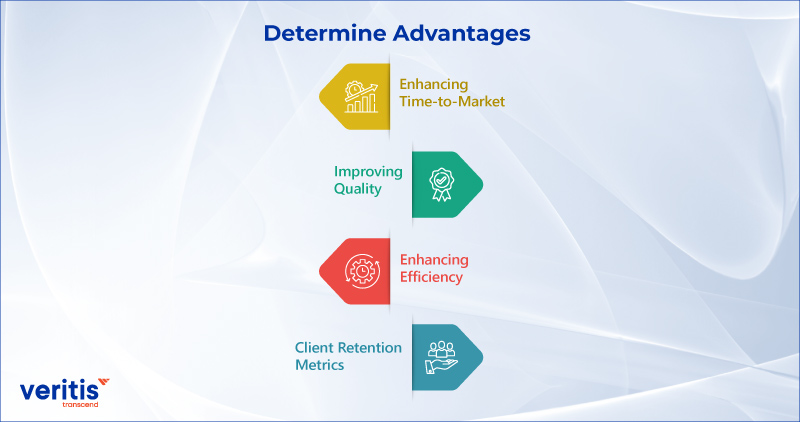
The subsequent step involves thoroughly evaluating the advantages DevOps confers upon your organization. By incorporating DevOps practices, you can scrutinize speed-to-market improvements, elevated quality standards, operational efficiency, and customer retention—key contributors to DevOps ROI.
1) Enhancing Time-to-Market
Quantify the improvement in time-to-market efficiency by eliminating development bottlenecks through enhanced collaboration and DevOps automation ROI, leading to quicker product or feature deliveries.
2) Improving Quality
Measure the reduction in defects, glitches, and production incidents through continuous testing, monitoring, and feedback loops, reflected in DevOps metrics.
3) Enhancing Efficiency
Evaluate the rise in productivity and resource optimization due to refined workflows, automated deployment processes, and better communication between development and operations teams.
4) Client Retention Metrics
Assess the influence of DevOps on customer satisfaction and loyalty through the analysis of DevOps ROI metrics, including decreased churn rates and improved user experience.
Useful link: Veritis Bags the CIO Review Award for Its Exceptional DevOps Solutions
Deriving ROI from DevOps
A 2023 leading global survey features DevOps among the top impacting technology trends globally compared to other trending solutions.
Here are some current statistics on the adoption and impact of DevOps:
- 99% of organizations report that DevOps has positively impacted their business.
- 61% say DevOps has helped them produce higher-quality deliverables.
- 49% of DevOps report a reduction in time-to-market software and services.
- The global DevOps market is estimated to grow USD 12.2 billion by 2026.
What made DevOps so special? The answer lies in its impact on organizational performance.
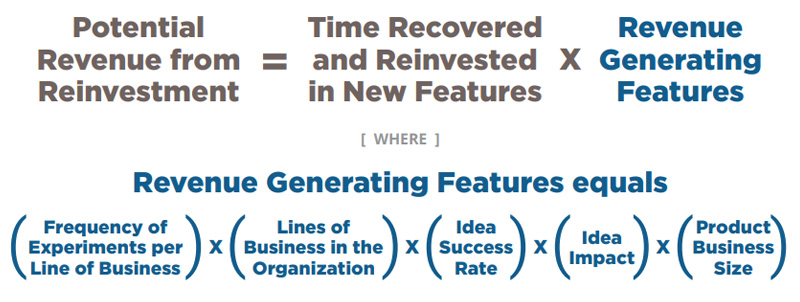
Here are Some More Current Statistics for DevOps:
Market growth
The global DevOps market is estimated to grow USD 24.71 billion by 2027, growing at a CAGR of 22.9% from 2023. (Source: Research and Markets)
The DevOps market is driven by the increasing adoption of cloud computing, continuous integration, continuous delivery (CI/CD), and containerization technologies.
Adoption
- 99% of IT professionals implementing DevOps say it has positively impacted their organization. (Source: Puppet)
- 61% of organizations say DevOps has helped them produce higher-quality deliverables. (Source: Puppet)
- 49% of organizations say that DevOps reports a reduction in time-to-market for software and services. (Source: Puppet)
Benefits
- DevOps organizations deploy software 200 times more frequently and recover from incidents 24 times faster than organizations that don’t use DevOps. (Source: DORA)
- DevOps organizations achieve 50% higher customer satisfaction rates than organizations that don’t use DevOps. (Source: DORA)
- DevOps organizations have 23% higher profitability than organizations that don’t use DevOps. (Source: DORA)
Trends
Some of the top DevOps trends for 2025 include:
- GitOps
- Observability
- Security as code
- Infrastructure as code (IaC)
- Kubernetes
- Multi-cloud and hybrid-cloud
Skills
The most in-demand DevOps skills in 2025 include:
- Cloud computing (AWS, Azure, GCP)
- Containerization (Docker, Kubernetes)
- CI/CD
- Infrastructure as code (IaC)
- Automation
- Programming languages (Python, Go, JavaScript)
These statistics demonstrate the continued growth and popularity of DevOps. Adopting DevOps practices should be a compelling consideration for organizations seeking enhancements in their software development and delivery processes.
Useful link: What is DevOps Services?
What to Measure for DevOps ROI?
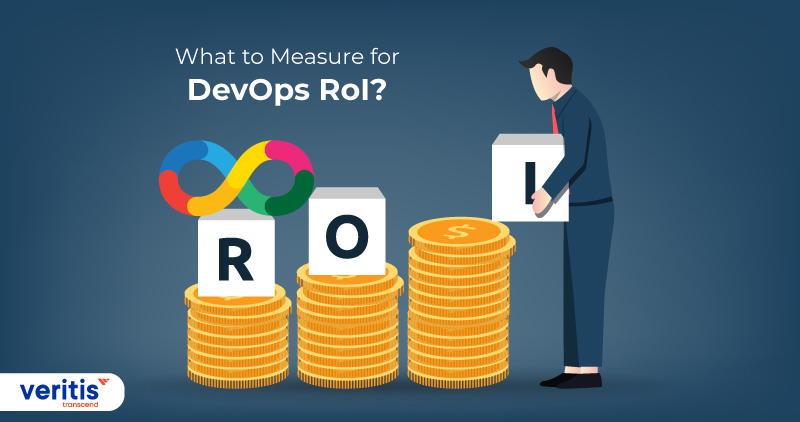
Return on Investment (ROI) is the first and foremost outcome that organizations expect when undertaking a new technology transformation. Specifically, when it comes to DevOps ROI, organizations must look beyond just technology acquisition and factor in training, lost productivity, maintenance, rearchitecting, and even replacement of existing systems.
ROI is typically measured in two broad ways: value-driven and cost-driven. Most organizations aim to improve processes to increase capacity instead of investing heavily in recruitment. Understanding how to measure DevOps ROI metrics is crucial to realizing both short-term and long-term value.
Key DevOps Metrics to Measure ROI
Measuring a successful DevOps ROI requires consideration of three distinct DevOps metrics: Performance, Philosophy, and Velocity.
1) DevOps ROI by Performance
This dimension evaluates how well different tiers of IT teams perform and benefit from DevOps:
High IT Performers – Realize substantial returns and achieve superior software delivery outcomes.
Medium IT Performers – Benefit by eliminating technical debt and focusing on speed and value.
Low IT Performers – Identify areas of improvement and use measurable goals to track progress.
2) DevOps ROI by Philosophy
This looks at how culture and mindset influence DevOps success:
People-Oriented – Focused on productivity, collaboration, and work quality.
Process-Oriented – Improvement via feedback loops, upgrades, and consistent deployments.
Technology-Oriented – Evaluates the ROI of hardware, software, and service functions as part of the DevOps ecosystem.
3) DevOps ROI by Velocity
Velocity-focused metrics reflect how quickly and efficiently your DevOps processes are operating:
Release Frequency – How often code is successfully pushed to production.
Infrastructure Recovery – How quickly systems recover from failures.
Infrastructure Resiliency – Measuring the reduction in downtime from infrastructure issues.
Infrastructure Efficiency – Ability to isolate resources to prevent deployment disruptions.
Automation – Reflects DevOps automation ROI by reducing manual efforts.
Iterations – Tracks the volume of changes made based on user feedback and continuous delivery.
While these DevOps metrics help map performance, measuring DevOps benefits for business outcomes requires a financial perspective as well.
Useful link: Top 10 DevOps Skills Every Aspiring DevOps Engineer Needs in 2025
Calculating ROI from DevOps
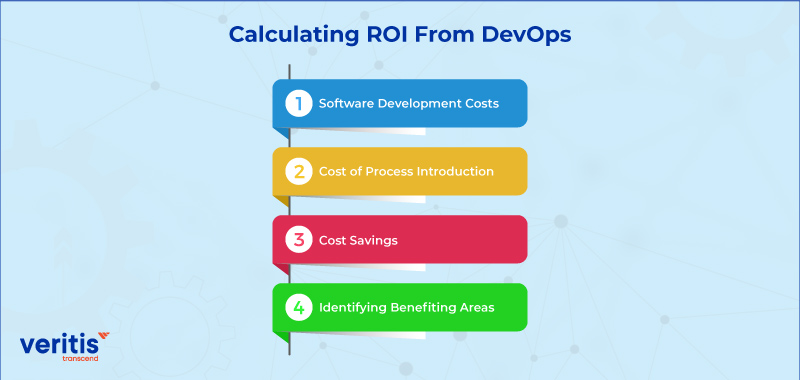
Calculating DevOps ROI from a DevOps strategy requires undergoing a four-step methodology:
1) Software Development Costs
Begin with a cost analysis of your current development efforts. Calculate the hourly cost of development by factoring in annual salaries, benefits, and employer overhead, then divide by total annual working hours. This helps establish a baseline for future DevOps cost savings.
2) Cost of Process Introduction
This includes the cost of implementing new processes like CI/CD, version control, automation pipelines, and security. Increased automation contributes significantly to DevOps automation ROI, as high-performing teams report less manual work.
Costs also include transitioning to new environments, upskilling teams, and tooling upgrades, all of which should be factored in to determine the actual investment.
3) Cost Savings
After implementation, calculate DevOps cost savings by identifying reductions in downtime, faster deployments, improved productivity, and fewer errors or bugs. These savings should be accurate and quantifiable for effective ROI tracking.
4) Identifying Benefiting Areas
Assess which areas have seen measurable improvement. Compare the DevOps ROI metrics by balancing the cost of implementation against the cost savings realized. Short-term ROI can be evaluated annually, while long-term ROI should span three years or more.
Compute DevOps ROI
To ascertain your DevOps ROI, divide the net benefits realized from implementing DevOps practices by the total costs expended. Multiply the outcome by 100 to represent it as a percentage.
ROI Calculation Equation:
ROI = (Net Benefits / Total Expenditures) * 100
Using this formula, you can gauge whether your DevOps investment generates favorable returns for your company.
Useful link: DevOps Implementation: 4 Steps to Success
DevOps Implementation Roadmap
Wait no more! Evaluate where you stand in your DevOps journey to optimize outcomes. With the right strategy, tooling, and culture in place, you can drive improved performance, higher efficiency, and 100% customer satisfaction—all while ensuring strong DevOps ROI.
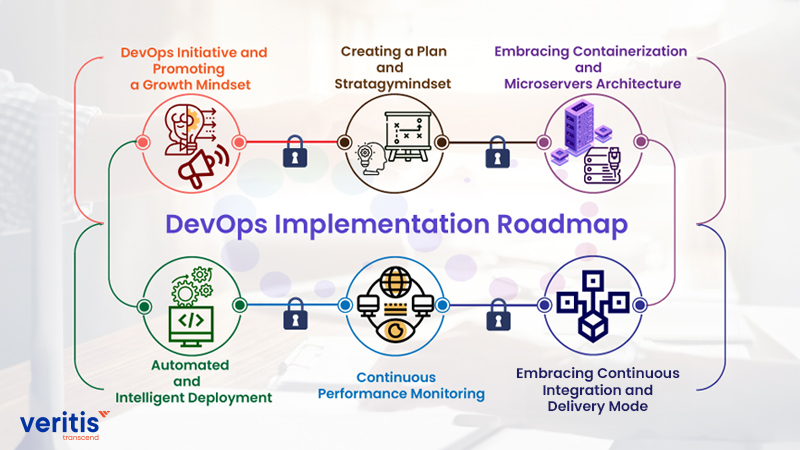
Case Study Highlight: Measuring DevOps ROI in the Oil & Gas Industry
A leading oil and gas service provider partnered with Veritis to implement DevOps enterprise management solutions that improved operational efficiency and security compliance. By leveraging targeted performance metrics and automation, they achieved measurable ROI through reduced downtime and optimized resource use, demonstrating the tangible business value of DevOps initiatives.
For detailed insights, explore the full case study: DevOps Enterprise Mgmt Support for Oil & Gas Service Provider.
Conclusion
DevOps has profoundly transformed software delivery by enhancing collaboration and accelerating delivery pipelines. This transformation brings measurable advantages—improved performance, productivity, time-to-market, and DevOps cost savings—while reducing failure rates and speeding up recovery.
As demand for DevOps continues to surge, organizations are turning to DevOps ROI metrics to quantify the value and justify investment. A structured ROI analysis offers actionable insights into the impact of DevOps automation ROI and guides businesses in resource allocation and continuous improvement.
Veritis, an award-winning industry leader and trusted partner in digital transformation, provides comprehensive DevOps services to help businesses maximize ROI and thrive in today’s competitive market. Backed by over 20 years of experience, Our team of certified AWS, Azure, and GCP consultants ensures 100% quality and client satisfaction, delivering customized solutions that align with business goals. Trusted by leading organizations such as Harshi Corp and AWS, Veritis stands as a symbol of excellence in driving successful DevOps transformations.
Looking for Support? Schedule A Call
Also Read:
- Measuring DevOps: Key ‘Metrics’ and ‘KPIs’ That Drive Success!
- Demystifying MLOps vs DevOps: Understanding the Key Differences
- AIOPS Solutions: Enhancing DevOps with Intelligent Automation for Optimized IT Operations
- Future of DevOps: Top DevOps Trends in 2025 and Beyond
- Explained: Pros and Cons of DevOps Methodology and its Principles
- How to Implement Artificial Intelligence in DevOps Transformation?